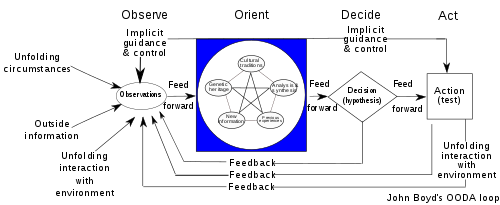The OODA loop (observe, orient, decide, act) is a decision-making model developed by United States Air Force Colonel John Boyd. He applied the concept to the combat operations process, often at the operational level during military campaigns. It is often applied to understand commercial operations and learning processes. The approach explains how agility can overcome raw power in dealing with human opponents.

The OODA loop
editAs can be seen from the diagram, the OODA loop includes continuous collection of feedback and observations. This enables late commitment, which is an important element of agility. This is in contrast to the PDCA cycle which requires early commitment (the first steps are Plan and Do).
Use in law and business
editThe OODA loop has become an important concept in litigation,[1] business,[2] law enforcement,[3] management education,[4][5] military strategy and cyber security, and cyberwarfare.[6] According to Boyd, decision-making occurs in an iterative cycle of "observe, orient, decide, act". An entity (whether an individual or an organization) that can process this cycle quickly, observing and reacting to unfolding events more rapidly and/or more effectively than an opponent, can thereby get inside the opponent's decision cycle and gain the advantage.
Jamie Dimon, chairman and CEO of JPMorgan Chase, has said he uses the OODA loop in scenario evaluation.[7][8][9]
Criticism
editSome scholars are critical of the concept. Aviation historian Michael Hankins, for example, writes that "the OODA loop is vague enough that its defenders and attackers can each see what they want to see in it. For some, the OODA concept's flexibility is its strength, but for others it becomes so generalized as to lose its usefulness." He concludes that "The OODA loop is merely one way among a myriad of ways of describing intuitive processes of learning and decision making that most people experience daily. It is not incorrect, but neither is it unique or especially profound."[10]
See also
editReferences
edit- ^ Dreier 2012, pp. 20–85.
- ^ Richards 2004, pp. 162–171.
- ^ Papenfuhs, Steve (Pappy) (15 February 2012). "The OODA loop, reaction time, and decision making". PoliceOne.com. Archived from the original on 25 January 2021. Retrieved 3 November 2016.
- ^ Ryder, Mike; Downs, Carolyn (November 2022). "Rethinking reflective practice: John Boyd's OODA loop as an alternative to Kolb". The International Journal of Management Education. 20 (3): 100703. doi:10.1016/j.ijme.2022.100703.
- ^ Ryder, Mike (2024). "Using OODA Loops to Build Sustainable Practice into Business Education". In Wall, Tony; Trevisan, Laís Viera; Filho, Walter Leal; Shore, Adam (eds.). Sustainability in Business Education, Research and Practices. World Sustainability Series. Springer. pp. 77–89. doi:10.1007/978-3-031-55996-9_6. ISBN 978-3-031-55995-2.
- ^ Clarke, Richard (2019). The Fifth Domain: Defending Our Country, Our Companies, and Ourselves in the Age of Cyber Threats. Penguin Press. p. 81. ISBN 978-0525561965.
- ^ Pringle, Eleanor (4 April 2024). "Jamie Dimon says he runs JPMorgan with a military tactic in mind named the 'OODA loop'". Fortune.
- ^ Pringle, Eleanor (29 October 2024). "Jamie Dimon says World War III may have already begun". Fortune.
- ^ "Jamie Dimon's Letter to Shareholders, Annual Report 2023 | JPMorganChase". www.jpmorganchase.com.
- ^ Hankins, Michael W. (2021). Flying Camelot: The F-15, the F-16, and the Weaponization of Fighter Pilot Nostalgia. Battlegrounds: Cornell Studies in Military History. Ithaca, NY: Cornell University Press. pp. 134–135. ISBN 9781501760655. OCLC 1245345653.
Bibliography
edit- Bazin, Aaron A. (January–February 2005). "Boyd's O-O-D-A loop and the infantry company commander" (PDF). Infantry. 94 (1): 17–19. ProQuest 219733932.
- Boyd, John R. (3 September 1976). Destruction and Creation (PDF). U.S. Army Command and General Staff College.
- Boyd, John, R. (28 June 1995). "The Essence of Winning and Losing". danford.net.
{{cite web}}: CS1 maint: multiple names: authors list (link) A supposed five-slide set by Boyd. - Dreier, A. S. (2012). Strategy, Planning & Litigating to Win: Orchestrating Trial Outcomes with Systems Theory, Psychology, Military Science, and Utility Theory. Boston, MA: Conatus Press. ISBN 978-0615676951. OCLC 917563752.
- Greene, Robert (24 February 2007). "OODA and You". powerseductionandwar.com.
- Hillaker, Harry (July 1997). "Tribute To John R. Boyd". Code One Magazine. Archived from the original on 17 September 2007.
- Osinga, Frans P. B. (2007) [2005]. Science, strategy and war: the strategic theory of John Boyd. Strategy and history. Vol. 18. London: Routledge. doi:10.4324/9780203088869. ISBN 0415371031. OCLC 67773991. PDF of the dissertation version.
- Owen, Jillian; Burstein, Frada; Hall, William P. (2004). "Knowledge reuse in project management". In Linger, Henry; Fisher, Julie; Wojtkowski, Wita; Wojtkowski, W. Gregory; Zupančič, Jože; Vigo, Kitty; Arnold, Josie (eds.). Constructing the Infrastructure for the Knowledge Economy: Methods and Tools, Theory and Structure. New York: Kluwer Academic/Plenum Publishers. pp. 443–454. doi:10.1007/978-1-4757-4852-9_33. ISBN 0306485540. OCLC 55877281.
- Richards, Chet (2004). Certain to Win: The Strategy of John Boyd, Applied to Business. Philadelphia: Xlibris. ISBN 1413453775. OCLC 57207751.
- Schuck, Tod (11 May 2017). "OODA Loop 2.0: Information, Not Agility, Is Life". Breaking Defense.
- Ullman, David G. (April 2007). "'OO-OO-OO!': the sound of a broken OODA loop" (PDF). CrossTalk: The Journal of Defense Software Engineering. 20 (4): 22–25. CiteSeerX 10.1.1.170.5341. Archived from the original (PDF) on 28 July 2012.
External links
edit- The John Boyd Library (archived documents by Boyd)